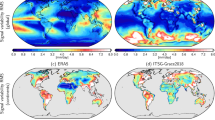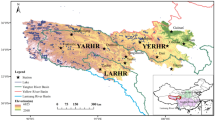Abstract
Global trend patterns of yearly mean total column water (TCW) from the European Centre for Medium Range Weather Forecasts (ECMWF) 20th century atmosphere model ERA-20CM (1900–2009) and the currently state-of-the-art reanalysis ERA-Interim (1979–2012) show common features of statistically significant upward trends. Of particular interest appears a pronounced regional dipole pattern of interannual climate variability over the South American continent particularly evident in ERA-Interim data. The trend dipole affects two distinct areas: the Andean Amazon basin and the Northeast Brazil. The target regions are characterized by rising and decreasing water content associated with water vapor convergence (divergence) and upward (downward) mass fluxes, respectively. As expected, local water vapor feedback due to local surface temperature change does to not fully explain this TCW trend dipole; other mechanisms may play a role in establishing the observed feature such as moisture transports and monsoon variability in the last decade. The observed trends of the normalized difference vegetation index (NDVI) during the period 1982–2005 show an increasing greenness that coincides with the moistening of the atmospheric column in the Amazon basin. These results are substantiated by two single-station ground-based GPS measurements of TCW vapor (TCWV) from the two target regions.













Similar content being viewed by others
References
Adler RF, Huffman GJ, Chang A, Ferraro R, Xie P-P, Janowiak J, Rudolf B, Schneider U, Curtis S, Bolvin D, Gruber A, Susskind J, Arkin P, Nelkin E (2003) The version-2 global precipitation climatology project (GPCP) monthly precipitation analysis (1979–present). J Hydrometeorol 4:1147–1167
Allan RP, Ringer MA, Pamment JA, Slingo A (2004) Simulation of the Earth’s radiation budget by the European Centre for Medium-Range Weather Forecasts 40-year reanalysis (ERA40). J Geophys Res 109:D18107. doi:10.1029/2004JD004816
Baldi G, Nosetto MD, Aragón R, Aversa F, Paruelo JM, Jobbágy EG (2008) Long-term satellite NDVI data sets: evaluating their ability to detect ecosystem functional changes in South America. Sensors 8:5397–5425
Becker A, Finger P, Meyer-Christoffer A, Rudolf B, Schamm K, Schneider U, Ziese M (2013) A description of the global land-surface precipitation data products of the Global Precipitation Climatology Centre with sample applications including centennial (trend) analysis from 1901–present. Earth Sys Sci Data 5:71–99
Bengtsson L, Hagemann S, Hodges KI (2004) Can climate trends be calculated from reanalysis data? J Geophys Res 109:D11111. doi:10.1029/2004JD004536
Berrisford P, Dee D, Fielding K, Fuentes M, Kallberg P, Kobayashi S, Uppala S (2009) The ERA-interim archive version 1.0. European Centre for Medium-Range Weather Forecasts ERA Report 1. ECMWF,UK, 16 pp
Berrisford P, Dee D, Poli P, Brugge R, Fielding K, Fuentes M, Kallberg P, Kobayashi S, Uppala S, Simmons A (2011) The ERA-interim archive version 2.0. European Centre for Medium-Range Weather Forecasts ERA Report 1. ECMWF, UK, 23 pp
Bevis M, Businger S, Chiswell S, Herring T, Anthes R, Rocken C, Ware R (1994) GPS meteorology: mapping zenith wet delays onto precipitable water. J Appl Meteorol 33:379–386
Bordi I, Sutera A (2004) Drought variability and its climatic implications. Glob Planet Chang 40:115–127
Bordi I, Fraedrich F, Sutera A, Zhu X (2014) Ground-based GPS measurements: time behavior from half-hour to years. Theor Appl Climatol 115:615–625
Byun SH, Bar-Sever YE (2009) A new type of troposphere zenith path delay product of the international GNSS service. J Geod 83:367–373
Clough SA, Iacono MJ (1995) Line-byline calculation of atmospheric fluxes and cooling rates 2. Application to carbon dioxide, ozone, methane, nitrous oxide and halocarbons. J Geophys Res 100:16519–16535
Dee DP et al (2011) ERA-Interim reanalysis: configuration and performance of the data assimilation system. Q J R Meteorol Soc 137:553–597
England MH, McGregor S, Spence P, Meehl GA, Timmermann A, Cai W, Gupta AS, McPhaden MJ, Purich A, Santoso A (2014) Recent intensification of wind-driven circulation in the Pacific and the ongoing warming hiatus. Nature Clim Chang 4:222–227
Fraedrich K, Kleidon A, Lunkeit F (1999) A green planet versus a desert world: estimating the effect of vegetation extremes on the atmosphere. J Clim 12:3156–3163
Gendt G (1998) IGS combination of tropospheric estimates – the pilot experiment. IGS 1997 Technical Reports. In: I Mueller, R Neilan, K Gowey(eds) IGS Analysis Center Workshop, October 1998 Jet Propulsion Lab, Pasadena, California, USA, p 265–269
Gloor M, Brienen RJW, Galbraith D, Feldpausch TR, Schöngart J, Guyot J-L, Espinoza JC, Lloyd J, Phillips OL (2013) Intensification of the Amazon hydrological cycle over the last two decades. Geophys Res Lett 40:1–5. doi:10.1002/grl.50377
Gutman SI, Sahm SR, Benjamin SG, Schwartz BE, Holub K, Stewart JQ, Smith TL (2004) Rapid retrieval and assimilation of ground based GPS precipitable water observations at the NOAA forecast systems laboratory: impact on weather forecasts. J Meteorol Soc Jpn 82:351–360
Harries J, Carli B, Rizzi R, Serio C, Mlynczak M, Palchetti L, Maestri T, Brindley H, Masiello G (2008) The far-infrared earth. Rev Geophys 46:RG4004. doi:10.1029/2007RG000233
Held IM, Soden BJ (2000) Water vapor feedback and global warming. Annu Rev Energy Environ 25:441–475
Hersbach H, Peubey C, Simmons A, Poli P, Dee D, Berrisford P (2013) ERA-20CM: a twentieth century atmospheric model ensemble. ECMWF ERA Report Series No. 16. ECMWF, UK
Karnauskas KB, Seager R, Kaplan A, Kushnir Y, Cane MA (2009) Observed strengthening of the zonal sea surface temperature gradient across the equatorial Pacific Ocean. J Clim 22:4316–4321
Kleidon A, Fraedrich K, Heimann M (2000) A green planet versus a desert world: estimating the maximum effect of vegetation on the land surface climate. Clim Chang 44:471–493
Li W, Zhang P, Ye J, Li L, Baker PA (2011) Impact of two different types of El Niño events on the Amazon climate and ecosystem productivity. J Plant Ecol 4:91–99
Lindzen RS (1990) Some coolness concerning global warming. Bull Am Meteorol Soc 71:288–299
Minschwaner K, Dessler AE (2004) Water vapor feedback in the tropical upper troposphere: model results and observations. J Clim 17:1272–1282
Ning T, Elgered G, Willén U, Johansson JM (2013) Evaluation of the atmospheric water vapor content in a regional climate model using ground-based GPS measurements. J Geophys Res Atmos 118:329–339
Pinzon JE, Brown ME, Tucker CJ (2005) Satellite time series correction of orbital drift artifacts using empirical mode decomposition. In: Huang NE, Shen SSP (eds) EMD and its applications. World Scientific, Singapore
Poli P, Hersbach H, Tan D, Dee D, Thépaut J-N, Simmons A, Peubey C, Laloyaux P, Komori T, Berrisford P, Dragani R, Trémolet Y, Holm E, Bonavita M, Isaksen L, Fisher M (2013) The data assimilation system and initial performance evaluation of the ECMWF pilot reanalysis of the 20th-century assimilating surface observations only (ERA-20C). ECMWF ERA Report Series No. 14. ECMWF, UK
Ren L, Arkin P, Smith TM, Shen SSP (2013) Global precipitation trends in 1900–2005 from a reconstruction and coupled model simulations. J Geophys Res Atmos 118:1679–1689
Scheftic W, Zeng X, Broxton P, Brunke M (2014) Intercomparison of seven NDVI products over United States and Mexico. Remote Sens 6:1057–1084
Schneider U, Becker A, Finger P, Meyer-Christoffer A, Rudolf B, Ziese M (2011) GPCC full data reanalysis version 6.0 at 0.5°: monthly land-surface precipitation from rain-gauges built on GTS-based and historic data. Theor Appl Climatol 115:15–40. doi:10.5676/DWD_GPCC/FD_M_V6_050
Schneider U, Becker A, Finger P, Meyer-Christoffer A, Ziese M, Rudolf B (2014) GPCC’s new land surface precipitation climatology based on quality-controlled in situ data and its role in quantifying the global water cycle. Theor Appl Climatol 115:15–40
Sellers PJ, Los SO, Tucker CJ, Justice CO, Dazlich DA, Collatz GJ, Randall DA (1994) A global 1 by 1 NDVI data set for climate studies. Part 2: the generation of global fields of terrestrial biophysical parameters from the NDVI. Int J Remote Sens 15:3519–3545
Silva VBS, Kousky VE (2012) The South American monsoon system: climatology and variability, modern climatology. In: Dr Shih-Yu Wang (ed) Modern Climatology InTech, Croatia
Simmons AJ, Poli P, Dee DP, Berrisford P, Hersbach H, Kobayashi S, Peubey C (2014) Estimating low-frequency variability and trends in atmospheric temperature using ERA-Interim. Q J R Meteorol Soc 140:329–353
Soden BJ, Jackson DL, Ramaswamy V, Schwarzkopf MD, Huang X (2005) The radiative signature of upper tropospheric moistening. Science 310:841–844
Sohn BJ, Yeh S-W, Schmetz J, Song H-J (2013) Observational evidences of walker circulation change over the last 30 years contrasting with GCM results. Clim Dyn 40:1721–1732
Sudradjat A, Ferraro RR, Fiorino M (2005) A comparison of total precipitable water between reanalyses and NVAP. J Clim 18:1790–1807
Trenberth KE, Fasullo JT (2013) An apparent hiatus in global warming? Earth’s Future 1:19–32
Trenberth KE, Fasullo J, Smith L (2005) Trends and variability in column-integrated atmospheric water vapour. Clim Dyn 24:741–758
Tucker CJ (1980) Remote sensing of leaf water content in the near infrared. Remote Sens Environ 10:23–32
Tucker CJ, Pinzon JE, Brown ME, Slaybeck DA, Pak EW, Mahoney R, Vermote EF, El Saleous N (2005) An extended AVHRR 8-km NDVI dataset compatible with MODIS and SPOT vegetation NDVI data. Int J Remote Sens 26:4485–4498
Vey S, Dietrich R, Rülke A, Fritsche M, Steigenberger P, Rothacher M (2010) Validation of precipitable water vapor within the NCEP/DOE reanalysis using global GPS observations from one decade. J Clim 23:1675–1695
Wang H, Fu R (2002) Cross-equatorial flow and seasonal cycle of precipitation over South America. J Clim 15:1591–1608
Wang J, Zhang L (2009) Climate applications of a global, 2-hourly atmospheric precipitable water dataset derived from IGS tropospheric products. J Geod 83:209–217
Wang J, Zhang L, Dai A, Van Hove T, Van Baelen J (2007) A near-global 2-hourly atmospheric precipitable water dataset from ground-based GPS measurements. J Geophys Res 112:D11107. doi:10.1029/2006JD007529
Acknowledgments
We acknowledge the ECMWF for the ERA-Interim data retrieved at their web site http://apps.ecmwf.int/datasets/. We also acknowledge the Earth Observing Laboratory, National Center for Atmospheric Research, University Corporation for Atmospheric Research, 2011: NCAR Global, 2-hourly Ground-Based GPS Precipitable Water. Research Data Archive at the National Center for Atmospheric Research, Computational and Information Systems Laboratory, Boulder, CO [available online at http://rda.ucar.edu/datasets/ds721.1], accessed 9 October 2013. NDVI data have been freely retrieved at the url http://glcf.umd.edu/data/gimms/index.shtml/. GPCP data were provided by the NOAA/ Office of Oceanic and Atmospheric Research/Earth System Research Laboratory (OAR/ESRL) Physical Sciences Division (PSD), Boulder, Colorado, USA, from their web site at http://www.esrl.noaa.gov/psd/. GPCC precipitation data were provided by the NOAA/OAR/ESRL PSD, Boulder, Colorado, USA, from their web site at http://www.esrl.noaa.gov/psd/. Support by the Max Planck Society is acknowledged (KF). This is a contribution to the BMBF-Project CarBioCial (BMBF/PTJ; FKZ: 01LL0902J).
Author information
Authors and Affiliations
Corresponding author
Rights and permissions
About this article
Cite this article
Bordi, I., De Bonis, R., Fraedrich, K. et al. Interannual variability patterns of the world’s total column water content: Amazon River basin. Theor Appl Climatol 122, 441–455 (2015). https://doi.org/10.1007/s00704-014-1304-y
Received:
Accepted:
Published:
Issue Date:
DOI: https://doi.org/10.1007/s00704-014-1304-y




